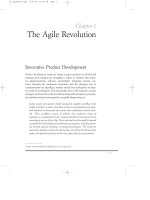The AI Revolution SPECIAL REPORT
Bạn đang xem bản rút gọn của tài liệu. Xem và tải ngay bản đầy đủ của tài liệu tại đây (545.14 KB, 17 trang )
SPECIAL REPORT
The AI
Revolution
Insights into the next era of customer relationships
About This Report
The AI Revolution
2
Today’s kindergarten students will never know a world without
artificial intelligence (AI), thanks to Apple’s Siri. Something as
commonplace as smartphone technology has put the power
of AI into the hands of every consumer. Unsurprisingly, customers’
expectations for smarter interactions are rising. Businesses are
likewise finding countless ways to infuse AI into everything from
their customer experiences to their internal operations.
To better understand this movement, Salesforce Research
compiled insights from its 2016 and 2017 global studies of
nearly 10,800 sales, service, and marketing leaders and over
7,000 consumers and business buyers. This report highlights
key findings around customers’ heightened expectations for
tailored, relevant experiences, and how businesses are using
AI to meet them.
Combined surveys generated responses from 10,785 full-time
sales, service, and marketing leaders (not limited to Salesforce
customers) from the U.S., Canada, Brazil, U.K./Ireland, France,
Germany, Japan, Australia/New Zealand, the Netherlands, and
the Nordics.* Due to rounding, notall percentage totals in this
report may equal 100%. All comparison calculations are made
from total numbers (not rounded numbers).
Salesforce Research provides data-driven insights
to help businesses transform how they drive customer
success. Browse all reports at salesforce.com/research.
*Note: Data attributed to Salesforce Research’s AI Snapshot Survey is sourced from U.S. respondents only.
Salesforce Research
Table of Contents
The AI Revolution
3
Customer Expectations Drive a New Era of Smarter Engagement................................................................................... 4
01
AI Steps into the Business Strategy Spotlight................................................................................................................. 5
02
AI’s Rise Mirrors Customers’ Elevated Expectations...................................................................................................... 6
03
Customers’ New View on Data Raises the Stakes for Companies............................................................................... 7
04
Loyalty Trends Hasten the AI Revolution......................................................................................................................... 8
Businesses Embrace AI to Meet the Challenge...................................................................................................................... 9
05
AI Use Cases Span Sales, Service, and Marketing......................................................................................................... 10
06
Deeper Relationships Hinge on Smarter Sales............................................................................................................... 11
07
Sales Teams See Returns on Early AI Investments........................................................................................................ 12
08
Intelligence Fuels Elevated Customer Service................................................................................................................ 13
09
Top Service Teams Project a Big Role for AI................................................................................................................... 14
10
Spotlight: Dynamic Content Ushers in Hyper-Personalized Marketing...................................................................... 15
Last Look: Companies Are Faced with Three Big AI Decisions.......................................................................................... 16
Salesforce Research
The AI Revolution
4
Customer Expectations
Drive a New Era of
Smarter Engagement
Salesforce Research
AI Steps into the Business Strategy Spotlight
We’re in the midst of a technology
revolution of unprecedented scale
and scope in which AI is driving historic
societal transformation. Additionally, AI
promises to re-architect business models
from the ground up — enabling companies
to get closer to their customers, design
hyper-personalized experiences, and
deliver relevant (even pre-emptive)
customer engagement in real time.
Just how much of a splash is AI making?
A recent survey of sales, service, and
marketing professionals in the U.S. shows
a growing eagerness to capitalize on the
opportunities AI presents. Already, 37%
of teams are using AI, and a further 22%
are piloting or evaluating such solutions.
Only 16% say their organization isn’t
interested in AI.
Clearly, a business world powered by
AI is upon us. But why now? Let’s take
a look at which trends have precipitated
this revolution.
The AI Revolution
5
AI Adoption Is on the Rise
While a minority of businesses use AI today, interest in the technology
is pervasive and planned adoption is strong.
Percentage of Sales, Service, and Marketing Leaders Who Describe
Their Organization’s Use of or Plans for AI as Follows
4%
Don’t know
21%
Use extensively
16%
Not interested
16%
Use selectively
21%
Interested
14%
Evaluating
Source: AI Snapshot Survey, Salesforce Research, February 2017.
8%
Piloting
Salesforce Research
AI’s Rise Mirrors Customers’ Elevated Expectations
For companies across different industries,
the increasing maturation of AI technology is
well-timed as they grapple with skyrocketing
customer expectations.
The power dynamic between customers and
companies has been reversed. Breakthroughs
in cloud, social, and mobile technology have
given customers more information, more choice,
and more flexibility than ever before. As a result,
58% of consumers and 75% of business buyers
say technology has significantly changed their
expectations of how companies should interact
with them.
Now, AI-powered developments like individualized
recommendations and automatic order fulfillments
are raising the bar against which customers judge
companies. Currently, 55% of consumers and 75%
of business buyers expect personalized offers. By
2020, 51% of consumers and 75% of business
buyers expect companies to anticipate their
needs and make relevant suggestions.
The AI Revolution
6
The Age of the Customer Brings Elevated Expectations of Companies
In addition to providing them with greater access to information than ever
before, technology has trained customers to expect individually tailored and,
increasingly, predictive experiences.
Percentage of Consumers and Business Buyers Who Agree
with the Following Statements
Technology has completely changed my expectations
of how companies should interact with me
77%
58%
I expect companies to understand my needs
and expectations
89%
72%
I expect companies to send me personalized offers
75%
55%
By 2020, I expect companies to anticipate my needs and
make relevant suggestions before I contact them
75%
51%
Business buyers
Consumers
Source: “State of the Connected Customer,” Salesforce Research, October 2016.
Salesforce Research
Customers’ New View on Data
Raises the Stakes for Companies
Data is at the heart of meeting the elevated
expectations of today’s connected customers.
When applied wisely, the flood of customer data
from countless devices and systems of record allows
companies to know precisely when, why, and how
to engage at the individual level.
However, many companies have held back on
leveraging that data — for fear of breaking customer
trust. For instance, tailored shopping experiences
can improve the customer experience, but risk
stepping over a “creepy” line. Only 12% of
customer service teams and 18% of sales
teams rate their ability to gather insights across
the entire customer lifecycle as either excellent
or outstanding.
The AI Revolution
Customers Are Willing to Share Data for Superior Experiences
Most customers understand that the personalized, predictive experiences they
expect are made possible by the collection, integration, and application of data.
Percentage of Consumers Who Agree They’re Willing to Share Personal
Data in Exchange for the Following
64%
58%
50%
Easier communications with companies
63%
58%
46%
Personalized offers or discounts
61%
52%
41%
Personalized in-store or online shopping experience
Yet, having grown accustomed to tailored,
individualized experiences, customer attitudes
towards their data have shifted significantly in
recent years. Customers now expect companies
to leverage their data, but expect a markedly
superior experience in return. For instance, 58%
of consumers are willing to share personal data
in exchange for a personalized in-store or online
shopping experience, and 52% say the same for
product recommendations that meet their needs.
Enthusiasm for this data value exchange is higher
for millennials.
7
58%
52%
42%
Product recommendations that match their needs
Millennials
Gen Xers
Baby Boomers/Traditionalists
Source: “State of the Connected Customer,” Salesforce Research, October 2016.
Salesforce Research
Loyalty Trends Hasten the AI Revolution
A key component of the Age of the Customer is
choice. Barriers to market entry have fallen, allowing
new competitors to disrupt established industries.
With a world of knowledge in their pockets at all
times, customers can explore new products, and
discover new alternatives, at the tap of a finger.
The competitive battleground is now squarely based
on superior customer experience. Empowered by
technology, customers are increasingly willing to
abandon companies unable to meet their new
expectations. For example, half of consumers
will switch from brands that don’t anticipate
their needs.
That lends further urgency to a company’s customercentric transition, and can spell disaster for those
that are unable to personalize experiences and
adapt to customer needs quickly enough. In this
climate of change, many firms are turning to AI to
accelerate their evolution.
8
The AI Revolution
Treating Customers Like Numbers Is a Dangerous Business Strategy
If companies don’t meet the elevated expectations of consumers and business
buyers for personalized, predictive experiences, a majority are willing to switch
to brands that will.
Percentage of Consumers and Business Buyers Who Are Likely To Switch
Brands If a Company Does the Following
Treats them like a number instead of an individual
72%
66%
Doesn’t make an effort to personalize their
communications to them
65%
52%
Doesn’t anticipate their needs
64%
50%
Business buyers
Consumers
Source: “State of the Connected Customer,” Salesforce Research, October 2016.
Salesforce Research
The AI Revolution
9
Businesses Embrace AI
to Meet the Challenge
Salesforce Research
AI Use Cases Span Sales, Service, and Marketing
Over time, AI has the potential to become as
ubiquitous as electricity or cloud computing.
Data suggests we’re not there yet, however. While
many companies expect to use AI, only a minority
are using it today. During this transitional stage,
the opportunity to use AI to win market share
is open to every enterprise.
Sales, service, and marketing leaders view AI as
a tool to drive better customer engagement and
increased revenue across their lines of business.
Sales and marketing teams, for example, see
opportunities to improve their lead scoring, while
customer service teams foresee more intelligent
classification and routing of their cases.
The AI Revolution
10
Customer-Centric Use Cases Are Viewed as Strong Contenders for AI
Ranking of Top AI Use Cases for Sales, Service, and Marketing Leaders
1
Sales and marketing lead scoring
2
Sales forecasting
3
Customer service case classification/routing
4
Sales opportunity scoring
5
Email marketing
This chart is a partial list.
Source: AI Snapshot Survey, Salesforce Research, February 2017.
Salesforce Research
Deeper Relationships Hinge on Smarter Sales
Sales teams are shifting from delivering transactions
to building relationships. Leading sales executives
strive to become trusted advisors, adding value
based on deep customer understanding.
In today’s landscape, that means providing
personalized, prescriptive, and even anticipatory
sales processes. In fact, no fewer than three-quarters
of sales teams have increased their focus on such
efforts over the past 12–18 months.
As companies move towards these lofty goals, a
clear relationship has emerged between teams
that are flourishing under a new dynamic, versus
those who are floundering. High-performing teams
— those who have significantly increased their
YoY revenue growth — are 3.1x more likely than
their underperforming counterparts — those with
negative YoY revenue growth — to currently use
AI, or plan to do so within a year.
The AI Revolution
11
Top Sales Teams Are More Likely to Meet New Objectives with AI
The role of sales is no longer one of order-taker. To succeed in the Age of the
Customer, sales teams are focusing on driving trusted advisor relationships with
customers through personalized and proactive engagement. Top sales teams
— those driving significant revenue growth under this new dynamic — are more
likely to leverage AI.
Percentage of Sales Teams That Have Increased Focus
on the Following over the Past 12–18 Months
Anticipating customer needs
78%
Being proactive
76%
Personalizing customer interactions
(e.g., providing relevant suggestions)
75%
Percentage of Sales Teams That Currently Use or Plan
to Use AI within 12 Months
High performers
63%
Moderate performers
34%
Underperformers
20%
Source: “State of Sales,” Salesforce Research, November 2016.
Salesforce Research
Sales Teams See Returns on Early AI Investments
There is already evidence that AI has a direct
impact on a company’s capacity to thrive in the
Age of the Customer. In the sales department,
intelligent selling is already driving productivity
improvements and increasing the speed at which
sales teams operate.
Eighty percent of teams using intelligent selling
say there has been a major or moderate positive
impact on their sales reps’ productivity, while
74% report a boost in sales velocity.
But more importantly, AI is helping sales
organizations make that critical shift from simply
facilitating transactions to building lasting, deep
relationships with customers. Among those already
using an intelligent sales capability, 83% report a
major or moderate positive impact on customer
retention, and 80% say the same for customer/
prospect nurturing.
The AI Revolution
12
Smarter Selling Yields Big Results
In addition to impacting their ability to drive deeper customer relationships,
users of intelligent sales capabilities report advantages to their operations.
Percentage of Sales Teams with Intelligent Sales Capabilities That Report
a Major or Moderate Positive Impact on the Following
Customer retention
83%
Customer/prospect nurturing
80%
Productivity of sales reps
80%
Sales velocity
74%
Forecast accuracy
73%
Pipeline generation
64%
This chart is a partial list.
Source: “State of Sales,” Salesforce Research, November 2016.
Salesforce Research
Intelligence Fuels Elevated Customer Service
Customer service teams are particularly impacted
by the Age of the Customer. In response to new
customer demands, service teams have begun to
dedicate themselves to achieving three key aims
— personalizing customer interactions, providing
proactive service, and taking into account a
customer’s unique journey with their organization.
As with their colleagues in sales, a relationship
between winning customer service teams and
the presence of intelligent capabilities is apparent.
High-performing service teams — those who rate
their performance versus the competition and
overall service performance as excellent — are
1.5x more likely to use AI than underperformers
— those who rate their performance versus the
competition as average or worse.
The AI Revolution
13
Service Teams That Excel Under Their New Mandate
Are More Likely To Leverage AI
Most customer service teams have pivoted their strategies with goals of providing
personalized and proactive customer experiences, but top teams — those whose
service outperforms the competition — are more likely to have adopted AI.
Percentage of Service Teams That Have Increased Focus
on the Following over the Past 12–18 Months
Personalizing service interactions
65%
Providing proactive service
62%
Providing service in the context
of customer journeys
61%
Percentage of Service Teams That Currently Use or Plan
to Use AI within 18 Months
High performers
72%
Moderate performers
58%
Underperformers
47%
Source: “State of Service,” Salesforce Research, January 2017.
Salesforce Research
Top Service Teams Project a Big Role for AI
Leading service teams appear to be following
their counterparts in sales. High performers are
working to integrate AI into everything they do, and
expect the technology to be a fundamental pillar
in their strategies to match up to sky-high customer
expectations in the years ahead.
High-performing service teams are nearly twice
as likely as underperformers to say that AI will
have a transformational or substantial impact on
their practices by 2020. Nearly two-thirds (66%)
of high performers share this sentiment, compared
to only one-third (34%) of underperformers.
The AI Revolution
14
Percentage of Service Teams That Believe AI Will Have
a Transformational or Substantial Impact on Customer
Service at Their Company by 2020
High performers
Moderate performers
Underperformers
High Performers vs.
Underperformers
1.9X
more likely to say AI will have
a transformational or substantial
impact by 2020
34%
65%
47%
Source: “State of Service,” Salesforce Research, January 2017.
Salesforce Research
Spotlight
Dynamic Content Ushers in Hyper-Personalized Marketing
Marketing departments are well-versed in using
personalization to build customer engagement,
but technological developments have raised the
bar on what constitutes a truly personalized
marketing experience.
In their quest to deepen customer relationships,
many marketers have moved from simple
segmentation to dynamic content strategies,
powered by machine learning, to tailor
communications and offers to individuals.
It’s becoming an increasingly popular tactic
amongst high performers. Ninety-two percent
of high-performing marketing teams — those
who are extremely satisfied with the current
outcomes realized as a direct result of their
marketing investment — use dynamic content
or plan to do so within 12 months. This
represents twice as many as underperforming
marketers — those who are slightly or not at all
satisfied with their outcomes.
The AI Revolution
15
Top Marketers Overwhelmingly Leverage Dynamic Content
Dynamic content presents marketers with an unprecedented opportunity to
engage individuals on their unique customer journeys. While more than nine
in 10 high-performing marketing teams — those most happy with the outcomes
of their marketing investments — have embraced dynamic content, less than half
of their underperforming counterparts have done the same.
Percentage of Marketing Teams That Currently Use
or Plan to Use Dynamic Content within 12 Months
92%
High Performers vs.
Underperformers
76%
2.0X
more likely
to us or plan to use
dynamic content
High performers
Moderate performers
Underperformers
45%
Source: “State of Marketing,” Salesforce Research, March 2016.
Salesforce Research
Last Look
Companies Are Faced with Three Big AI Decisions
The AI Revolution
16
As companies look to leverage AI to help them compete in the Age of the Customer,
three decisions loom large.
Where should you apply AI?
Only 16% of sales, service, and marketing execs say they’ve completely defined their processes
for embedding the outcomes of AI analysis into their business practices.†
AI can certainly play a role for companies looking to deliver on elevated customer expectations.
But recognizing AI’s potential isn’t enough. To derive real value, companies must carefully examine
how the technology will fit into their specific business processes.
How can you drive buy in?
Only 23% of business users with interest in AI say they have complete confidence in the capacity/
bandwidth of their employees to execute on an AI business strategy.†
Business users must be assured that AI adds value and helps them drive deeper engagement with
customers, rather than adding a technology-based hurdle to their daily duties. To help drive adoption
across the company, evangelists must show business users how AI adds value and drives meaningfully
deeper engagement.
Do you make or buy?
82% of IT teams say they’re experiencing a skills gap in data science, or anticipate such a skills gap within two years.*
Many companies have identified a challenging skills gap when implementing AI in their business. Others plan
on partnering to sidestep the challenge of hiring a full team of data scientists. There’s a major decision for companies
to make — balancing the imperative to own their differentiator and the necessity of entering into a battle for
data science competency.
† Source: AI Snapshot Survey, Salesforce Research, February 2017.
* Source: “State of IT”, Salesforce Research, April 2017.
Salesforce Research
Browse all reports at salesforce.com/research.









